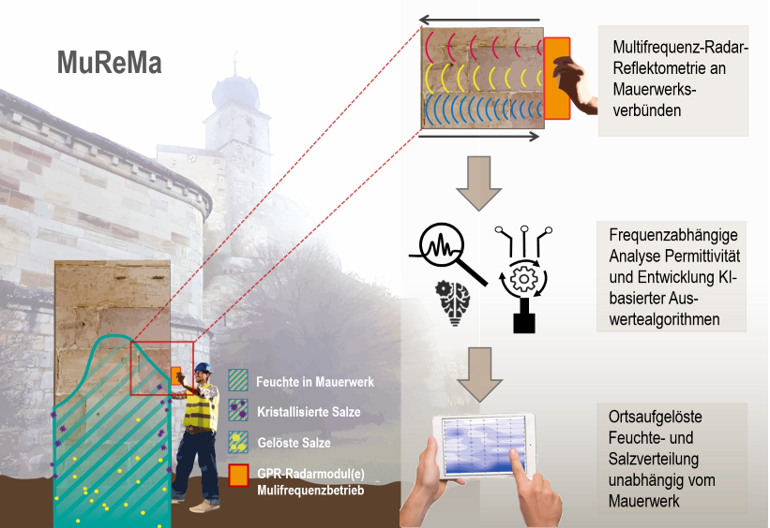Multifrequenz-Reflektometrie zur Analyse des Feuchte– und Salzgehaltes in Mauerwerk
Kurzbeschreibung
Ziel des Projektes ist Entwicklung eines Messsystems zur Bestimmung von Salz- und Feuchtebelastung in historischem Mauerwerk. Dabei kommt die tiefenabhängige zeitaufgelöste Reflektometrie mittels elektromagnetischer Wellen unterschiedlicher Frequenzen zur Anwendung. Die Messmethode der Reflektometrie stellt sicher, dass nur ein einseitiger Zugang zum Mauerwerk erforderlich ist. Oberhalb einer Frequenz von 100-200 MHz lässt sich so der Effekt von Salz und Feuchte auf den Real- und Imaginärteil der komplexen Dielektrizitätskonstante auftrennen und messtechnisch separieren.
Optimale Multifrequenzkombination
Ziel der geplanten Untersuchungen ist die Identifikation einer optimalen Multifrequenzkombination, mit der sich auch dicke Wände von historischem Mauerwerk bis in die Tiefe von mindestens 50 cm im Reflexionsmodus vermessen lassen und eine ortsabhängige Aussage zu Salz-, Feuchtegehalt und vorliegenden Salzarten erlauben. Weiterhin soll untersucht werden, wie über die Anwendung von „Machine learning-Algorithmen“ auch aus bisher nicht oder nur schlecht auswertbaren Signalen eine Messinformation extrahiert werden kann. Über eine Mehrfrequenzmessung soll außerdem erreicht werden, dass - unabhängig von der Art des Mauerwerks - auf den Feuchte- und Salzgehalt geschlossen werden kann.
Machine Learning-Algorithmen
Vorgesehen ist ein
Labortest an bauwerkstypischen Mauerwerksmodellen mit verschiedenen
Feuchte- und Salzkonzentrationen, Feuchte- und Salzprofilen sowie
unterschiedlichen Salzarten bei mehreren Frequenzen. Auf Grundlage der
Messdaten werden Simulationsmodelle zur Beschreibung der Experimente
entwickelt bzw. angepasst. Zudem werden Auswertealgorithmen entwickelt,
die auf „Machine Learning-Algorithmen“ basieren. Nach der Etablierung
der Modelle im Laborversuch erfolgt ein finaler Test im Feld an realem
Mauerwerk. Sowohl bei den Laborversuchen als auch bei den Feldtests
werden die aus den Messdaten abgeleiteten Werte für Feuchte, Salzgehalt
und Salzarten mit den über etablierten Methoden gewonnenen Referenzdaten
verglichen.
test
1
Frenzel, Daniel; Blaschke, Oliver; Franzen, Christoph; Brand, Felix; Haas, Franziska; Troi, Alexandra; Drese, Klaus Stefan (2023)
Frenzel, Daniel; Blaschke, Oliver; Franzen, Christoph; Brand, Felix; Haas, Franziska...
Vortrag: Salt Weathering of Buildings and Stone Sculptures Asia 2023, 195-206.
Quantification of Moisture in Masonry via AI Evaluated Broadband Radar Reflectometry
Frenzel, Daniel; Blaschke, Oliver; Franzen, Christoph; Brand, Felix; Haas, Franziska; Troi, Alexandra; Drese, Klaus Stefan (2023)
Frenzel, Daniel; Blaschke, Oliver; Franzen, Christoph; Brand, Felix; Haas, Franziska...
Heritage 6 (7), 5030-5050.
Humidity, salt content, and migration in building materials lead to
weathering and are a common challenge. To understand damage phenomena
and select the right conservation treatments, knowledge on both the
amount and distribution of moisture and salt load in the masonry is
crucial. It was shown that commercial portable devices addressing
moisture are often limited by the mutual interference of these values.
This can be improved by exploiting broadband radar reflectometry for the
quantification of humidity in historic masonry. Due to the
above-mentioned limitations, today’s gold standard for evaluating the
moisture content in historic buildings is still conducted by taking
drilling samples with a subsequent evaluation in a specially designed
laboratory, the so-called Darr method. In this paper, a new broadband
frequency approach in the range between 0.4 and 6 GHz with improved
artificial-intelligence data analysis makes sure to optimize the
reflected signal, simplify the evaluation of the generated data, and
minimise the effects of variables such as salt contamination that
influence the permittivity. In this way, the amount of water could be
determined independently from the salt content in the material and an
estimate of the salt load. With new machine learning algorithms, the
analysis of the permittivity is improved and can be made accessible for
everyday use on building sites with minimal intervention by the user.
These algorithms were trained with generated data from different drying
studies on single building bricks from the masonries. The findings from
the laboratory studies were then validated and evaluated on real
historic buildings at real construction sites. Thus, the paper shows a
spatially resolved and salt-independent measurement system for
determining building moisture.Quantification of Moisture in Masonry via AI-Evaluated Broadband Radar Reflectometry
DOI: 10.3390/heritage6070266
Open Access
Peer Reviewed
Blaschke, Oliver; Brand, Felix; Drese, Klaus Stefan (2023)
Sensors 23 (10), 4616.
For the investigation of moisture and salt content in historic masonry,
destructive drilling samples followed by a gravimetric investigation is
still the preferred method. In order to prevent the destructive
intrusion into the building substance and to enable a large-area
measurement, a nondestructive and easy-to-use measuring principle is
needed. Previous systems for moisture measurement usually fail due to a
strong dependence on contained salts. In this work, a ground penetrating
radar (GPR) system was used to determine the frequency-dependent
complex permittivity in the range between 1 and 3 GHz on salt-loaded
samples of historical building materials. By choosing this frequency
range, it was possible to determine the moisture in the samples
independently of the salt content. In addition, it was possible to make a
quantitative statement about the salt level. The applied method
demonstrates that with ground penetrating radar measurements in the
frequency range selected here, a salt-independent moisture determination
can be carried out.Quantification of Humidity and Salt Detection in Historical Building Materials via Broadband Radar Measurement
DOI: 10.3390/s23104616
Open Access
Peer Reviewed
Teilprojektleitung
T 09561317522 klaus.drese[at]hs-coburg.de
ORCID iD: 0000-0001-8829-1161
Projektmitwirkung
T +49 9561 317 542 Oliver.Blaschke[at]hs-coburg.de
T +49 9561 317 Daniel.Frenzel[at]hs-coburg.de
Institut für Diagnostik und Konservierung an Denkmalen in Sachsen und Sachsen-Anhalt e.V. (IDK)


